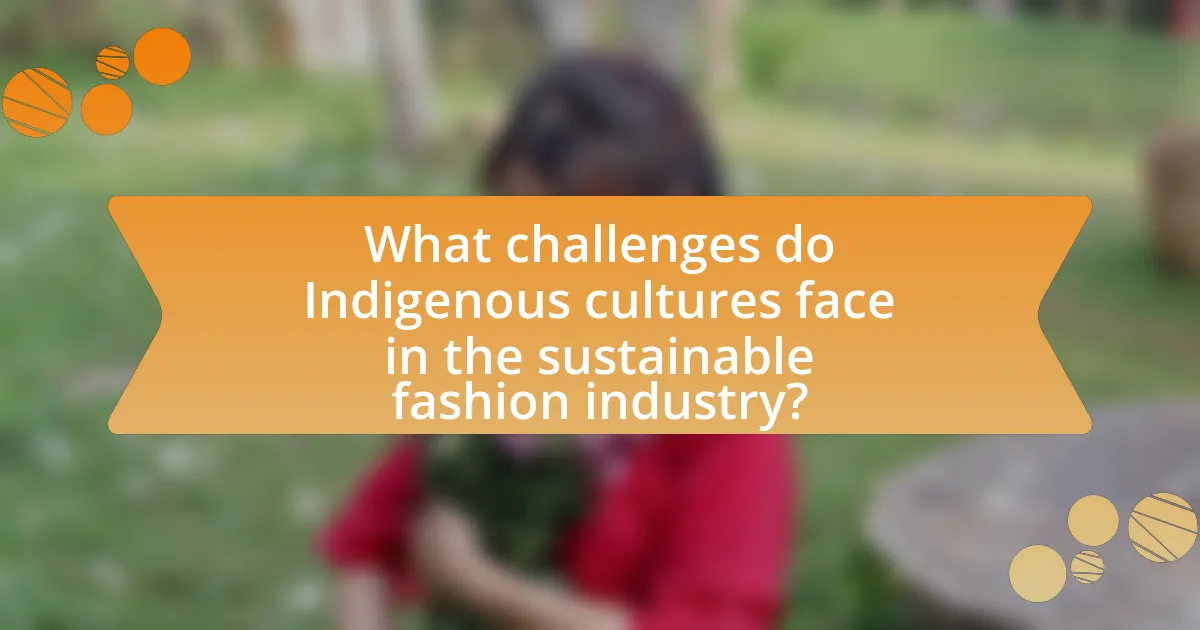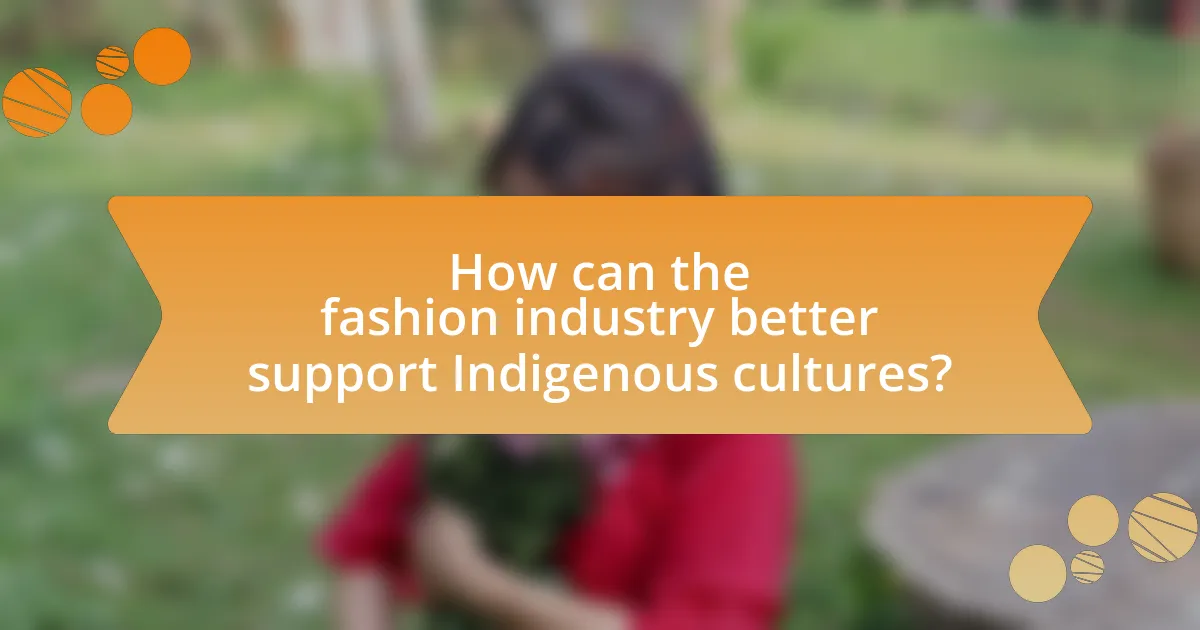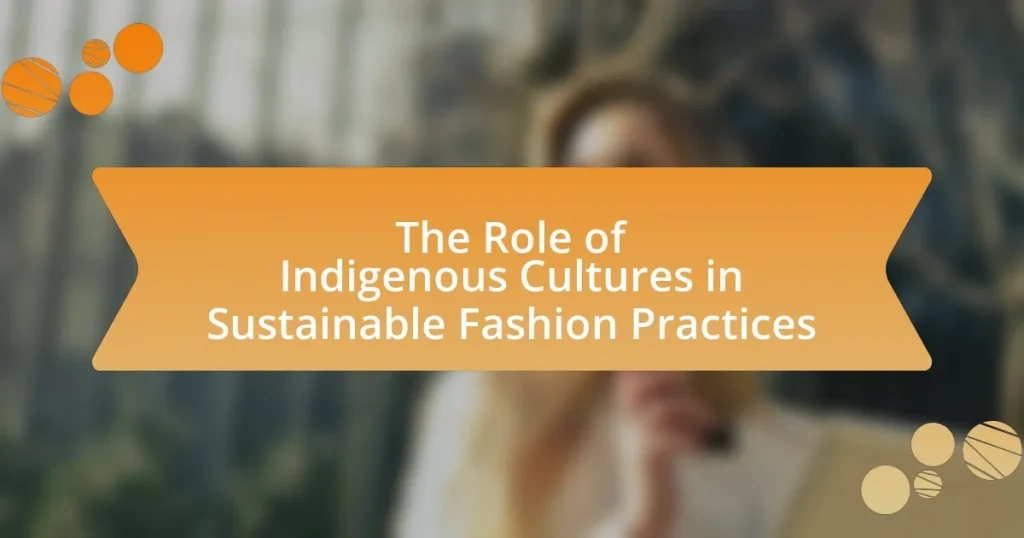The article examines the significant role of Indigenous cultures in sustainable fashion practices, highlighting their use of traditional techniques, natural materials, and ethical values that prioritize environmental stewardship and community well-being. It discusses how Indigenous craftsmanship, such as natural dyeing and hand weaving, contributes to eco-friendly production processes while preserving cultural heritage. The article also addresses the challenges Indigenous communities face, including cultural appropriation and economic barriers, and emphasizes the importance of collaboration between Indigenous artisans and fashion brands to promote authentic representation and fair trade practices. Additionally, it outlines practical steps consumers can take to support Indigenous sustainable fashion initiatives.

What is the Role of Indigenous Cultures in Sustainable Fashion Practices?
Indigenous cultures play a crucial role in sustainable fashion practices by promoting traditional techniques, materials, and ethical values that prioritize environmental stewardship and community well-being. These cultures often utilize natural fibers, dyes, and sustainable methods passed down through generations, which contribute to eco-friendly production processes. For instance, the use of organic cotton and plant-based dyes in Indigenous textiles reduces chemical pollution and supports biodiversity. Furthermore, Indigenous fashion emphasizes the importance of cultural identity and storytelling, fostering a deeper connection between consumers and the products they purchase. This approach not only preserves cultural heritage but also encourages sustainable consumption patterns, as seen in the growing popularity of Indigenous-designed fashion brands that advocate for ethical practices and fair trade.
How do Indigenous cultures influence sustainable fashion practices?
Indigenous cultures influence sustainable fashion practices by emphasizing traditional craftsmanship, ecological stewardship, and cultural heritage. These cultures often utilize natural materials and age-old techniques that minimize environmental impact, such as using plant-based dyes and sustainable fibers. For instance, the Navajo Nation’s weaving practices not only produce unique textiles but also promote biodiversity by sourcing materials locally. Additionally, Indigenous fashion often incorporates storytelling and cultural symbols, fostering a deeper connection between consumers and the products. This approach aligns with sustainable fashion principles by prioritizing ethical production and cultural preservation, as seen in initiatives like the Indigenous Fashion Arts organization, which supports Indigenous designers and promotes their sustainable practices.
What traditional techniques are utilized in sustainable fashion by Indigenous cultures?
Indigenous cultures utilize techniques such as natural dyeing, hand weaving, and traditional sewing methods in sustainable fashion. These practices often involve the use of locally sourced materials, such as plant fibers and animal hides, which minimizes environmental impact. For example, the Navajo Nation employs hand-spinning and weaving techniques to create textiles that reflect cultural heritage while promoting sustainability. Additionally, many Indigenous groups practice the art of natural dyeing using plants, which not only provides vibrant colors but also reduces reliance on synthetic dyes that can harm ecosystems. These traditional methods are integral to preserving cultural identity and promoting ecological balance in fashion.
How do Indigenous values shape the principles of sustainable fashion?
Indigenous values shape the principles of sustainable fashion by emphasizing respect for nature, community, and cultural heritage. These values promote practices that prioritize ecological balance, such as using natural materials and traditional techniques that minimize environmental impact. For instance, many Indigenous communities advocate for slow fashion, which contrasts with fast fashion’s wastefulness, by creating garments that are durable and meaningful. Additionally, Indigenous perspectives often include a holistic view of the environment, recognizing the interconnectedness of all living things, which informs sustainable sourcing and production methods. This approach is supported by the fact that Indigenous peoples have historically practiced sustainable land management and resource use, as seen in their traditional ecological knowledge, which has been recognized by various studies, including those published by the United Nations.
Why is it important to incorporate Indigenous cultures in sustainable fashion?
Incorporating Indigenous cultures in sustainable fashion is important because it promotes biodiversity, traditional craftsmanship, and ethical practices. Indigenous communities possess extensive knowledge of local ecosystems and sustainable resource management, which can enhance the environmental sustainability of fashion. For instance, the use of natural dyes and materials sourced from local flora, as practiced by various Indigenous groups, reduces reliance on synthetic chemicals and promotes ecological balance. Additionally, integrating Indigenous perspectives fosters cultural diversity and respect, which are essential for creating a more inclusive and responsible fashion industry. This approach not only preserves cultural heritage but also supports the economic empowerment of Indigenous artisans, as seen in initiatives that prioritize fair trade and equitable partnerships.
What are the environmental benefits of Indigenous practices in fashion?
Indigenous practices in fashion provide significant environmental benefits, primarily through sustainable resource management and the use of natural materials. These practices often emphasize the importance of biodiversity, as Indigenous communities traditionally utilize local flora and fauna in a way that maintains ecological balance. For instance, the use of plant-based dyes and fibers reduces reliance on synthetic materials, which are harmful to the environment. Additionally, Indigenous methods often involve low-impact production techniques that minimize waste and energy consumption, contributing to a smaller carbon footprint. Research indicates that these practices can lead to healthier ecosystems, as they promote the conservation of native species and habitats, thereby enhancing overall environmental resilience.
How does Indigenous knowledge contribute to biodiversity in fashion materials?
Indigenous knowledge significantly contributes to biodiversity in fashion materials by promoting the use of native plants and sustainable harvesting practices. This traditional ecological knowledge encompasses an understanding of local ecosystems, which enables Indigenous communities to cultivate and utilize materials that are both environmentally sustainable and culturally significant. For instance, Indigenous practices often involve the use of natural dyes derived from local flora, which not only reduces reliance on synthetic chemicals but also supports the conservation of plant species. Furthermore, studies have shown that Indigenous land management techniques, such as controlled burns and crop rotation, enhance biodiversity by maintaining healthy ecosystems, which in turn provides a diverse range of materials for fashion. This integration of Indigenous knowledge into fashion not only preserves biodiversity but also fosters a deeper connection between cultural heritage and sustainable practices.

What challenges do Indigenous cultures face in the sustainable fashion industry?
Indigenous cultures face significant challenges in the sustainable fashion industry, primarily due to cultural appropriation, lack of representation, and economic barriers. Cultural appropriation occurs when non-Indigenous designers exploit Indigenous designs and symbols without permission or compensation, undermining the cultural significance of these elements. Additionally, Indigenous communities often lack representation in decision-making processes within the fashion industry, which leads to their needs and perspectives being overlooked. Economic barriers further complicate their participation, as many Indigenous artisans struggle to access markets and resources necessary for sustainable production. These challenges hinder the ability of Indigenous cultures to fully engage in and benefit from the sustainable fashion movement.
How does cultural appropriation impact Indigenous contributions to fashion?
Cultural appropriation negatively impacts Indigenous contributions to fashion by undermining the authenticity and value of their cultural expressions. When non-Indigenous designers adopt Indigenous designs without permission or understanding, it often leads to the commodification of sacred symbols and traditional practices, stripping them of their cultural significance. For instance, the use of Indigenous patterns in mainstream fashion can result in financial gain for non-Indigenous entities while Indigenous creators receive little to no recognition or compensation for their work. This dynamic not only perpetuates stereotypes but also hinders the ability of Indigenous communities to maintain their cultural heritage and economic independence in the fashion industry.
What are the legal implications of cultural appropriation in fashion?
Cultural appropriation in fashion can lead to legal implications primarily related to intellectual property rights, trademark infringement, and potential violations of cultural heritage laws. When designers use elements from Indigenous cultures without permission, they may infringe on the rights of those cultures to control their traditional knowledge and expressions. For instance, the United States has laws like the Indian Arts and Crafts Act, which prohibits misrepresentation of Indian-made goods, thereby protecting Indigenous artisans from exploitation. Additionally, some countries have enacted laws that recognize the collective intellectual property rights of Indigenous peoples, allowing them to seek legal recourse against unauthorized use of their cultural symbols and designs. These legal frameworks aim to safeguard cultural heritage and ensure that Indigenous communities benefit from their cultural expressions.
How can Indigenous communities protect their cultural heritage in fashion?
Indigenous communities can protect their cultural heritage in fashion by implementing legal frameworks such as intellectual property rights and cultural heritage laws. These frameworks enable Indigenous peoples to assert ownership over traditional designs, patterns, and techniques, preventing unauthorized use by non-Indigenous designers. For instance, the Native American Arts and Crafts Act in the United States prohibits misrepresentation of Native American-made goods, thereby safeguarding Indigenous artistry. Additionally, Indigenous communities can engage in collaborative partnerships with ethical fashion brands to promote authentic representation and ensure that profits benefit the community. This approach not only preserves cultural identity but also fosters sustainable economic development within Indigenous populations.
What economic challenges do Indigenous artisans encounter in sustainable fashion?
Indigenous artisans encounter significant economic challenges in sustainable fashion, primarily due to limited access to markets and resources. These artisans often struggle to compete with mass-produced fashion items, which are cheaper and more widely available, leading to reduced visibility and sales for their unique, culturally significant products. Additionally, many Indigenous artisans face barriers such as lack of funding, inadequate infrastructure, and insufficient support from governmental and non-governmental organizations, which hinders their ability to scale production and reach broader audiences. According to a report by the United Nations, Indigenous peoples are disproportionately affected by economic marginalization, which further exacerbates these challenges in the sustainable fashion sector.
How does access to markets affect Indigenous artisans in the fashion industry?
Access to markets significantly enhances the economic viability and cultural preservation of Indigenous artisans in the fashion industry. When Indigenous artisans gain access to broader markets, they can sell their unique, culturally significant products, which not only provides them with a sustainable income but also promotes their traditional craftsmanship. For instance, a study by the United Nations Conference on Trade and Development (UNCTAD) highlights that access to global markets can increase the income of Indigenous artisans by up to 30%, allowing them to invest in their communities and preserve their cultural heritage. This economic empowerment fosters a sense of identity and pride among Indigenous artisans, reinforcing the importance of their cultural contributions to sustainable fashion practices.
What role do fair trade practices play in supporting Indigenous fashion initiatives?
Fair trade practices play a crucial role in supporting Indigenous fashion initiatives by ensuring equitable compensation and sustainable development for Indigenous artisans. These practices promote direct trade relationships, allowing Indigenous creators to receive fair wages that reflect the true value of their craftsmanship. For instance, fair trade organizations often provide training and resources that empower Indigenous communities, fostering economic independence and cultural preservation. According to the World Fair Organization, fair trade can increase income for artisans by 20-50%, which directly benefits their communities and supports the continuation of traditional practices. This economic support enables Indigenous fashion initiatives to thrive while maintaining cultural integrity and promoting sustainable practices.

How can the fashion industry better support Indigenous cultures?
The fashion industry can better support Indigenous cultures by prioritizing collaboration with Indigenous designers and artisans. This collaboration ensures that Indigenous voices are heard and respected in the design process, allowing for authentic representation of their cultural heritage. For instance, brands like Bodega and OXDX Clothing have successfully partnered with Indigenous artists to create collections that reflect traditional designs while providing fair compensation and recognition. Additionally, the industry can implement policies that protect Indigenous intellectual property rights, preventing cultural appropriation and ensuring that Indigenous communities benefit economically from their cultural expressions. By fostering these partnerships and respecting cultural rights, the fashion industry can contribute to the preservation and celebration of Indigenous cultures.
What collaborative efforts exist between Indigenous communities and fashion brands?
Collaborative efforts between Indigenous communities and fashion brands often involve partnerships that emphasize cultural heritage and sustainable practices. For instance, brands like Patagonia have worked with Indigenous artisans to incorporate traditional techniques and materials into their products, promoting both cultural preservation and environmental sustainability. Additionally, the brand Oiselle has collaborated with Indigenous designers to create collections that reflect Indigenous aesthetics while providing economic opportunities for these communities. These collaborations not only enhance the authenticity of fashion items but also support Indigenous economies and promote awareness of their cultural narratives.
How can partnerships enhance the visibility of Indigenous fashion practices?
Partnerships can enhance the visibility of Indigenous fashion practices by providing platforms for collaboration and exposure to broader audiences. Collaborations between Indigenous designers and established fashion brands or organizations can lead to increased media coverage and participation in major fashion events, thereby showcasing Indigenous craftsmanship and cultural narratives. For instance, partnerships with fashion weeks or cultural festivals can highlight Indigenous designs, attracting attention from consumers and industry stakeholders alike. This visibility not only promotes the unique aesthetics of Indigenous fashion but also educates the public about the cultural significance and sustainable practices inherent in these traditions.
What are successful case studies of Indigenous collaboration in fashion?
Successful case studies of Indigenous collaboration in fashion include the partnership between the Indigenous fashion designer Bethany Yellowtail and the brand B. Yellowtail, which focuses on authentic Native American designs and storytelling. This collaboration emphasizes cultural heritage while promoting sustainable practices through the use of eco-friendly materials. Another notable example is the collaboration between the Australian Indigenous brand Ngali and various Indigenous artists, which showcases traditional art forms in contemporary fashion, thereby supporting local artisans and preserving cultural narratives. These collaborations not only enhance visibility for Indigenous cultures but also contribute to sustainable fashion by prioritizing ethical production methods and community engagement.
What best practices can fashion brands adopt to honor Indigenous cultures?
Fashion brands can honor Indigenous cultures by engaging in meaningful collaboration with Indigenous communities. This involves consulting with Indigenous leaders and artisans to ensure that cultural elements are represented accurately and respectfully in designs. For instance, brands can incorporate traditional techniques and materials, which not only preserves these practices but also provides economic opportunities for Indigenous artisans.
Additionally, fashion brands should prioritize transparency in their supply chains, ensuring that Indigenous communities are fairly compensated for their contributions. According to a report by the United Nations, ethical sourcing and fair trade practices can significantly benefit Indigenous populations by promoting their cultural heritage while providing sustainable livelihoods.
Moreover, educating consumers about the significance of Indigenous cultures and the stories behind the designs can foster appreciation and respect. This approach aligns with the principles of sustainable fashion, which advocate for cultural sensitivity and environmental stewardship.
How can brands ensure ethical sourcing of materials from Indigenous communities?
Brands can ensure ethical sourcing of materials from Indigenous communities by establishing direct partnerships and engaging in fair trade practices. This approach involves collaborating with Indigenous leaders and organizations to understand their cultural values and rights, ensuring that the communities benefit economically from the materials sourced. For instance, the United Nations Declaration on the Rights of Indigenous Peoples emphasizes the importance of obtaining free, prior, and informed consent from Indigenous communities before utilizing their resources. By adhering to this principle, brands can foster trust and accountability, ultimately leading to sustainable and respectful relationships that honor Indigenous cultures and promote ethical practices in the fashion industry.
What strategies can brands implement to promote Indigenous designers and artisans?
Brands can implement strategies such as collaborating with Indigenous designers, showcasing their work in marketing campaigns, and providing platforms for their stories. Collaborations allow brands to leverage the unique cultural perspectives and craftsmanship of Indigenous artisans, enhancing authenticity and consumer connection. Marketing campaigns that highlight the heritage and skills of these designers can raise awareness and appreciation for Indigenous cultures. Additionally, creating platforms, such as pop-up shops or online marketplaces, specifically for Indigenous artisans can facilitate direct access to their products, ensuring fair compensation and visibility. These strategies not only promote Indigenous talent but also align with sustainable fashion practices by valuing traditional craftsmanship and cultural narratives.
What practical steps can consumers take to support Indigenous sustainable fashion?
Consumers can support Indigenous sustainable fashion by purchasing directly from Indigenous designers and brands. This practice ensures that profits go to the communities that create the fashion, promoting economic empowerment. Additionally, consumers can educate themselves about the cultural significance of the designs and materials used, fostering respect and appreciation for Indigenous heritage. Supporting initiatives that focus on sustainable practices, such as eco-friendly materials and ethical labor, further aligns consumer choices with Indigenous values. Engaging in advocacy for policies that protect Indigenous rights and intellectual property in fashion also contributes to the sustainability of these practices.



